The Botho Project Space, which adjoins Nelson Makamo’s studio in Selby. (Image courtesy of Botho Project Space)
It is hard to pinpoint exactly when works by artist Nelson Makamo became so hotly coveted. If you study auction records, his art was fetching handsome sums before Oprah Winfrey posted an image on Instagram of herself virtually hugging a newly acquired artwork by the Jo’burg-based artist.
Then there was the artwork Makamo made for the cover of Time magazine, and the Trevor Noah interview in 2019. He has more than 180 000 followers on Instagram. Yet despite his celebrity status and the rising value of his art, Makamo is not represented by an art gallery.
He has staged exhibitions at galleries — often the Everard Read — but has maintained his independence. This may be due to the perceived lack of institutional appeal (from museums and curators) his art presents, which may have been a barrier to him landing a spot at Goodman or Stevenson — two of the country’s most powerful art galleries and art-marketing machines.
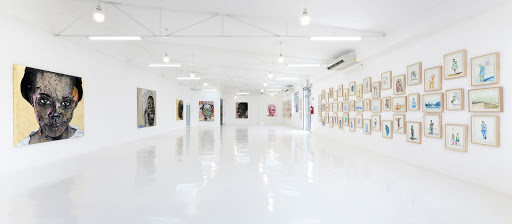 Makamo opened possibly the largest exhibition of his works to date at Botho Project Space in November last year. (Image courtesy of Botho Project Space)
Makamo opened possibly the largest exhibition of his works to date at Botho Project Space in November last year. (Image courtesy of Botho Project Space)
Whether Makamo was waiting to be courted by a powerful gallery or had no interest
in this is a moot point for he has now completely taken control of his destiny and set up his own gallery. Botho Project Space adjoins his studio in Selby and it is here that he opened possibly the largest exhibition of his works to date in November last year.
The gallery is unconventional in a number of ways. It sold tickets — R450 for two — to attend the opening nights (because of Covid-19). This idea was well received; it was sold out (more than 300 tickets) three days before the opening. The opening show, naturally, was a Makamo solo — a mass of new paintings filled the capacious destination, which includes one large gallery, a corridor and another smaller gallery space.
A keynote address on the role of artists in postcolonial Africa added conceptual weight to the opening night. A comprehensive catalogue on Makamo’s art was published. “It made sense to open with Nelson, he had not shown a solo show in South Africa in a long time. We won’t only do solos but group shows, where we invite writers, curators to curate or contribute. We are also working on an international strategy to promote our shows. We don’t have one format,” says French-born Anne Reverdy, the director of Botho Project Space.
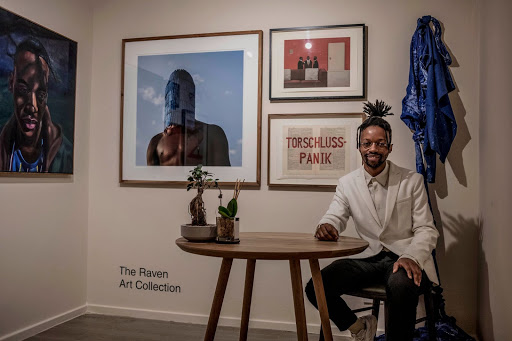 Since opening BKhz, artist Banele Khoza has also operated as a gallerist, putting on a string of exhibitions and participating in art fairs. (Photo: Paul Botes)
Since opening BKhz, artist Banele Khoza has also operated as a gallerist, putting on a string of exhibitions and participating in art fairs. (Photo: Paul Botes)
Makamo isn’t the only South African artist who has chosen to set up his own gallery — Banele Khoza beat him to it when he opened BKhz in Braamfontein in 2018. At the time Khoza’s establishment puzzled the local art community — not only was the purpose of the new space unclear but why would he opt out of the gallery system when he was such a promising talent? From a young age, when his ambitions lay in fashion, Khoza dreamed of his own atelier and it remained a steadfast goal even when his passion for art became clear. As such, BKhz was modelled on an atelier of sorts.
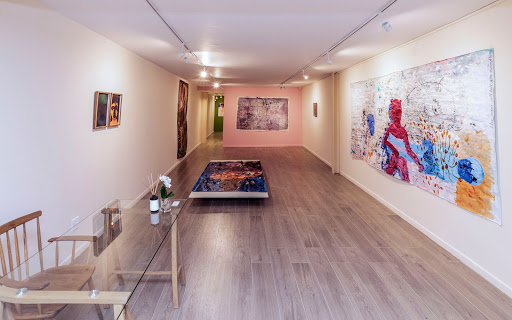 BKhz’s new space on the ground floor of the Trumpet building in Rosebank, which opened in January, marks an evolution into more of a conventional gallery. (Photo: Paul Botes)
BKhz’s new space on the ground floor of the Trumpet building in Rosebank, which opened in January, marks an evolution into more of a conventional gallery. (Photo: Paul Botes)
“My initial plan was to have a studio and a home for my work where people could view it in a setting where they could experience it. Then the landlord gave me more space, I moved my art to the back and decided to put on curatorial projects at the front,” said Khoza. Little did he know then that he would find himself a gallerist, putting on a string of exhibitions, and participating in art fairs. BKhz’s new space on the ground floor of the Trumpet building in Rosebank, which opened in January, marks an evolution into more of a conventional gallery.
Yet it remains a space for Khoza to promote his art too — his solo exhibition, 27, opened last month.
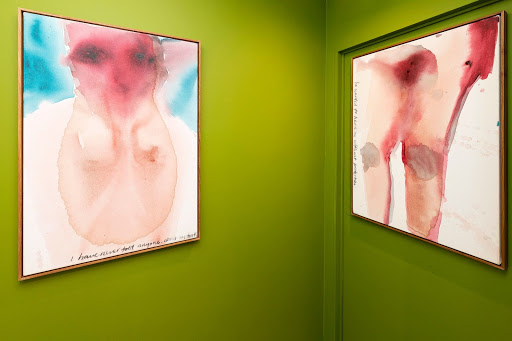 Banele Khoza’s I have never told anyone about my first (acrylic ink on canvas) and He wanted to have me without protection (acrylic ink on canvas), both featured in his new exhibition 27. (Photo: Paul Botes)
Banele Khoza’s I have never told anyone about my first (acrylic ink on canvas) and He wanted to have me without protection (acrylic ink on canvas), both featured in his new exhibition 27. (Photo: Paul Botes)
Khoza and Makamo are part of a shift in the local and international art worlds. Social media platforms, such as Instagram, are directly connecting a new generation of artists to collectors. They hire a manager who deals with sales, collectors and exhibitions. Even young graduates with a hot following — such as Zandile Tshabalala — have managers. In this way Tshabalala sets the prices for her art. Of course, many say those prices grow too fast and the artist should follow gallery conventions.
“The gallery format worked 10 years ago, when it was difficult for collectors to reach artists. Now they can go directly to the artist so it doesn’t make sense to share 40% of your profits,” says Musa Nxumalo, a Jo’burg-based artist involved in setting up Botho Project Space.
 A catalog of Nelson Makamo’s recent exhibition Botho Motho Batho. (Image courtesy of Botho Project Space)
A catalog of Nelson Makamo’s recent exhibition Botho Motho Batho. (Image courtesy of Botho Project Space)
Instagram might bring in sales, but it is a virtual medium. Nothing can quite replace the solo exhibition — a format that allows collectors to really get a feel for an artist’s aesthetic and ideas.
“Galleries are important because of exhibitions, but artists also want to be free to collaborate with other artists who may be aligned to different galleries or show in different spaces. The current gallery system hasn’t allowed for this,” says Nxumalo. Artist-run galleries appear to offer the artists the best of both worlds — complete control over their practice but also the ability to sell at art fairs and stage solo exhibitions.
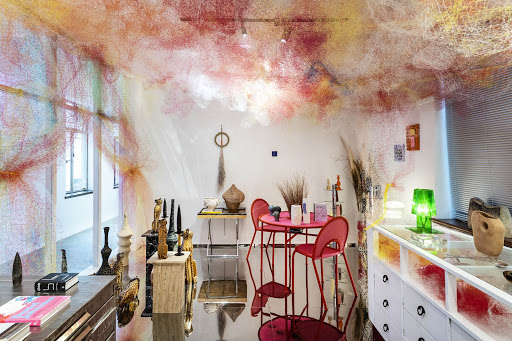 An installation view of The Spectacle on show at The Fourth in Cape Town. (Photo: Paris Brummer)
An installation view of The Spectacle on show at The Fourth in Cape Town. (Photo: Paris Brummer)
Like Botho Project Space, The Fourth, which was opened late last year by artist Rodan Kane-Hart, does not represent artists. This Cape Town gallery, located on the titular fourth floor of an old building off St Georges Mall, is a venue for exhibitions with works by many artists who may or may not be represented by galleries. The Fourth grew out of a smaller “gallery” in Kane-Hart’s loft apartment.
When the apartment a floor below became vacant because of Covid-19 pressures, the landlord offered it to him. With more space to play, Kane-Hart pushed new boundaries by curating exhibitions in which works of art and design — such as pieces of furniture — are shown alongside each other.
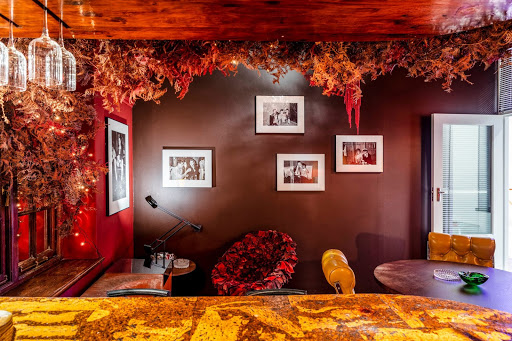 Each adjoining room in the exhibition space is dedicated to a different thread of the larger Spectacle theme, allowing relationships between the art and design objects to connect in particular ways. (Image courtesy of The Fourth)
Each adjoining room in the exhibition space is dedicated to a different thread of the larger Spectacle theme, allowing relationships between the art and design objects to connect in particular ways. (Image courtesy of The Fourth)
As such, a walk through The Fourth’s latest show, The Spectacle, feels a little like entering an interior magazine spread. A textile work by Unathi Mkonto is displayed next to a side table by Ben Kennedy and an Artemide lamp. This set-up suits the setting, an expansive flat with myriad adjoining rooms. Each is dedicated to a different thread of the larger Spectacle theme, allowing relationships between the art and design objects to connect in particular ways.
Some of the conversations between designers and artists were instigated before the making of some of the artworks, such as an installation of red sculptural works fashioned from layers of angel hair by Galia Gluckman. They were an extension of the textural works from the Soirée series that evolved in response to working with fashion stylist Louw Kotze.
 Cape of Good Hope and The Colour of Life, Galia Gluckman, 2020, on show at The Fourth in Cape Town. (Image courtesy of The Fourth)
Cape of Good Hope and The Colour of Life, Galia Gluckman, 2020, on show at The Fourth in Cape Town. (Image courtesy of The Fourth)
Conversations between artists and creatives have perhaps been stifled by the current gallery system. This may explain the absence of stories about South African art itself in most of the recent museum shows — the majority of exhibitions at the Zeitz Museum of Contemporary Art Africa and the Norval Foundation are solo surveys. No one seems interested in or able to join the dots between artists and their works.
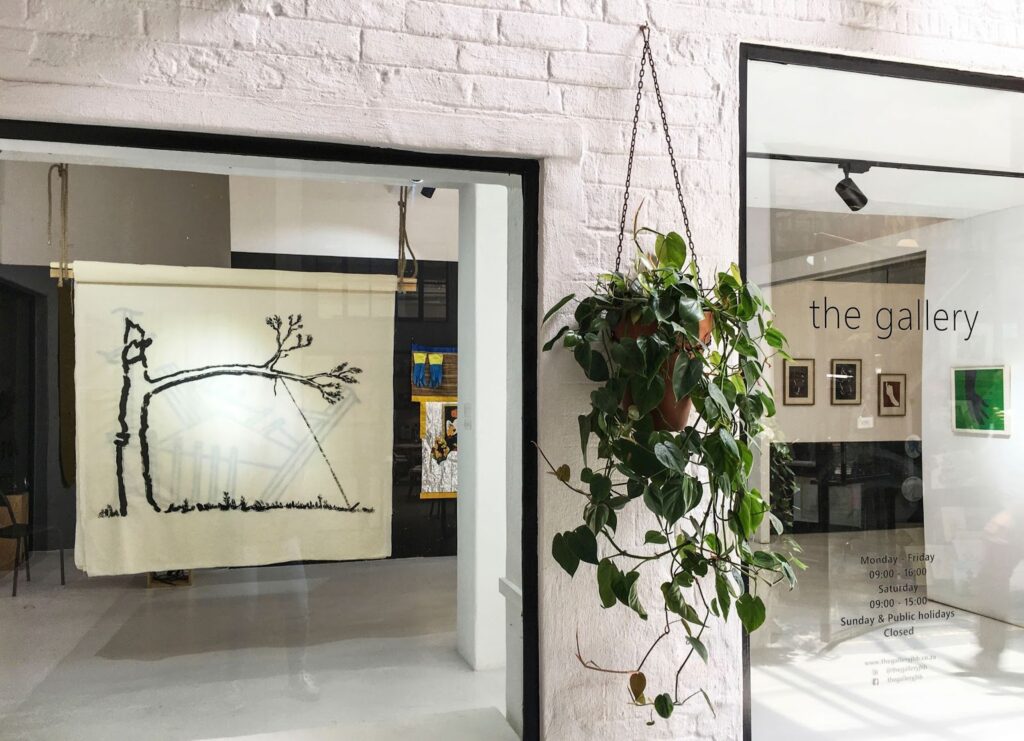 The Gallery, which opened at 44 Stanley in 2019, aims to diversify models of exhibition-making in South Africa. (Photo: Paul Botes)
The Gallery, which opened at 44 Stanley in 2019, aims to diversify models of exhibition-making in South Africa. (Photo: Paul Botes)
The Gallery at 44 Stanley aims “to consider what contemporary practices have in common”: its exhibition programme has been dominated by group exhibitions drawing lines between the ways different artists are responding to the current climate. This space opened in late 2019, the brainchild of artist Chloë Reid, in partnership with artist Fiona Pole and Didier Presse (who founded the atelier where editioned works are printed and sold alongside art books).
 The Gallery’s Chloë Reid, Kundai Moyo, Didier Presse, Fiona Pole and Balekane Legoabe. (Photo: Paul Botes)
The Gallery’s Chloë Reid, Kundai Moyo, Didier Presse, Fiona Pole and Balekane Legoabe. (Photo: Paul Botes)
After Reid returned from living in Scotland, where she was exposed to many artist-driven initiatives, she was inspired to set up a space “to encourage collaboration, dialogue and exchange between artists, writers and curators. It is an experiment that stems in part from my interest in seeing more diversity in the models for exhibition-making in South Africa and finding alternatives to the almost exclusive focus on individual practices in our art space. We’re very much working it out as we go along,” says Reid.
The most recent exhibition at the gallery is curated by artist Balekane Legoabe and Pole. It includes works by older, mid-career artists who have fallen out of the gallery system loop — such as Jonah Sack and Bridget Baker — alongside promising newcomers such as Siyabonga Mahlaba.
 Siyabonga Mahlaba’s Modimo O Lerato, which is currently being exhibited at The Gallery at 44 Stanley. (Image courtesy of The Fourth)
Siyabonga Mahlaba’s Modimo O Lerato, which is currently being exhibited at The Gallery at 44 Stanley. (Image courtesy of The Fourth)
Although the South African gallery landscape has grown and doubled in size in the past decade, its evolution has seen a reduction in spaces for new graduates and emerging artists. Artist-run galleries might provide alternatives for these artists, says Gordon Froud, an artist and head of the visual arts department at the University of Johannesburg.
“Covid seems to have spurred more emerging artists to do it for themselves, finding their own way of marketing. They are rejecting the gallery system, as they realise that we can do it almost as well as they [galleries] can,” Froud says. “We used to rent out galleries for student shows; now we just do short-run pop-ups and the sales are better.”